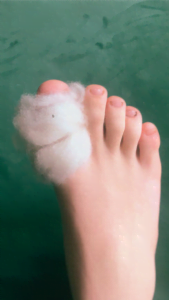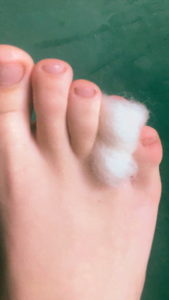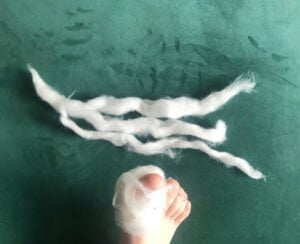What is Hiker’s Wool?
Hiker’s Wool: An Explanation
When you first come out of  Podiatry school, you feel like you are cutting edge, and have all the answers on how you are going to help people (at least I did). Hiker's Wool for blister prevention, Lambs wool seems like an outdated, useless solution, and something you would never consider using in these modern times..
Podiatry school, you feel like you are cutting edge, and have all the answers on how you are going to help people (at least I did). Hiker's Wool for blister prevention, Lambs wool seems like an outdated, useless solution, and something you would never consider using in these modern times..
However, 20 years later, that is exactly what I am using, and it works really well.
Nature has spent thousands of years perfecting its materials for protection and effectiveness. I recently did the Milford Track, and one of the ladies on that trip was having some problems, and had Hikers Wool, but did not know how to use it.
Hikers Wool is made from 100%pure New Zealand’s lambswool – it is beautifully soft, lanolin rich, washed and intricately carded to provide a soft cushioning effect for your feet. The wonderful quality of the wool absorbs moisture and prevents rubbing and irritation from friction and compression (chafing).It is easily molded around toes and feet.
When to use Hikers Wool for Blister Prevention
I use it with patients who have;
- Rheumatoid arthritis
- Chilblains
- Corns between their toes and other pressure areas
- Prevention of blisters in between toes
- Pressure areas under a foot
How to use Hikers Wool for Blister Prevention
Hiker's Wool helps to decompress that. It is nice and soft, molds around the painful area, provides friction free comfort and wicks away the moisture.
In between toes
Two toes can rub together, causing pressure and pain, particularly if they are in a boot. Take a strand of Hikers Wool, start in between a toe, and wrap it around the toe and the next one. Don't pull tight; when you have a couple of layers, tuck the end in and gently put on your sock.
To protect a bunion
Pull off a strand, start between the big toe and the next one, and wrap around as low over the bunion as you can. After a couple of layers, tuck the end in and gently put on your sock.
Over a hammertoe
Pull off a strand and wrap a couple of layers around the raised knuckle.
Underfoot
Ball some wool up and stick to your insole where you find it gets the most pressure.
Hikers Wool for Blister Prevention
How to use it depends on which  toes are affected. For example, if it was the little toe, I would get the carded section of wool, and pull out as much as I needed. Then gently wrap it around the toe, making sure you don’t do it too tight. I normally only wrap it round a couple of times, and sometimes use the adjacent toe to help with security.
toes are affected. For example, if it was the little toe, I would get the carded section of wool, and pull out as much as I needed. Then gently wrap it around the toe, making sure you don’t do it too tight. I normally only wrap it round a couple of times, and sometimes use the adjacent toe to help with security.
What you will find is that the wool sort of mats up, and almost makes a little sleeve for your toes. Or you can apply a fresh dressing every day – it is really up to you.
Another problem that affects a lot of walkers are the dreaded blister, for help on how to prevent and treat a blister, read this blog.
To Book an Appointment with our Podiatry Team here at Waikato Podiatry, call us on 07 838 0003, or use our Online Booking Portal.
